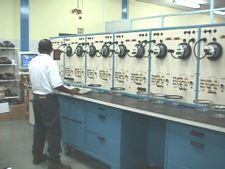Reading Your Meter
Your electricity meter is a precision instrument which has been tested and installed to measure the energy consumed on your premises. It records the number of units (kilowatt hours) of electricity you have used. It is quite easy to read, and consumption records are simple to keep.
Your meter records electricity usage and gives T&TEC the ability to accurately and fairly generate your electricity bills. Your meter will be one of the following :
- Digital Meters
- Dial Meters
- AMI Meters
By recording your readings regularly, you can calculate and monitor your consumption of energy. This could assist you in controlling the amount of power you use.
Digital Meters
The number of units of electricity used is shown by a simple row of figures. The reading on the digital meter is the total number of units used since the meter was installed. To keep a check on your consumption, simply subtract the previous reading from the new reading.
The correct meter reading above is 21050 units.
To read a digital meter, merely record the numbers exactly as they appear.
Dial Meters
This type of meter appears to be more difficult to read but after a little practice you will find it quite straightforward. Dial Meters have small dials on them which rotate and register usage with the flow of electricity. When reading your dial meter, always remember that adjacent dials revolve in opposite directions as shown in the illustration below. First, ignore the dial marked 1/10 (it is only there for testing purposes).
The reading above is : 44918
- Read the dials on your electric meter from RIGHT TO LEFT (5 to 1)
- But record the reading from LEFT TO RIGHT
- If the dial hand is between two numbers, record the lower of the two. Pay attention to the direction in which the hands are turning.
- If the dial is on a particular number:
Record that number: if the hand on the dial to the immediate right is just past 0
Record the lower number: if the hand on the dial to the immediate right is just approaching 0.
- Write down the number for each dial.
- Subtract the last reading taken from your reading and then multiply the difference by the meter multiplier to determine the amount of kilowatt-hours (kWh) used.
As with the digital meter drawing. When you have worked out the reading, subtract the previous reading shown on your bill to find the number of units of electricity used.
Remember: Before you read your dial meter, check the direction of your dials. They may not be exactly like those in the example shown.
METER ACCURACY
Have you ever received a higher than expected electricity bill and wondered “Is my meter running fast?” Well, it could be a number of things…house guests, an additional appliance, other extra use, parties or fetes, appliances in a state of disrepair, e.g. refrigerator with faulty door seals.
Before you call T&TEC and request a check on your meter, there are some things you need to know about your meter and how to determine higher than expected power consumption :
Electricity meters must meet strict accuracy requirements set by manufacturers. Regulations require that meters be tested and approved before they are put into use. Each installed meter is sealed to prevent tampering and contamination. Periodically, installed meters are sample tested to ensure they remain accurate within strict margins. This doesn’t mean they are perfect but it does significantly reduce the risk of inaccuracy. When a meter does start to lose its accuracy, it tends to slow down and thus favours the home owner. Even then, the discrepancy is very small; from .005 to .01 percent. It is in the interest of the consumer to draw to the Commission’s attention instances of “fast running”, “slow running” or “stopped” meters as soon as possible so that corrective measures could be taken promptly.
Extraordinary use
If your bill is high, take the opportunity to track down unusually high electricity consumption. During the rainy season, clothes dryer usage increases because of the weather. Or during Carnival, Christmas, Easter, Divali or other festive occasions significantly more baking, oven roasting and cooking on the whole is done.
Compare billing periods
Remember that the number of days in each billing period may vary so that an objective basis of comparison is the daily average consumption in successive billing periods. There are other possible explanations for a higher than expected reading.
UNSCHEDULED METER READINGS
T&TEC reads your meter every four months or every other billing period. Every second billing period we estimate your consumption based on past billing periods. Then, when a reading is done, the accumulated difference of the past estimates might result in a higher or lower than expected billing for you. You can determine if the meter reading was an estimate or an actual by looking for the word “estimate” on the bill face.
IF THERE IS NO OTHER EXPLANATION
If you’ve monitored your electricity consumption and you still suspect your meter is fast or faulty, you can requisition a test of the meter at any of T&TEC’s service centres. A technician will be sent to inspect and test it.
COST OF CHECKING METER
If your meter is tested and found to be in good working condition, a fee of $194.00 plus VAT will be charged to your account. If it is found to not be working within the acceptable limits of accuracy, T&TEC will absorb the cost of the exercise.



